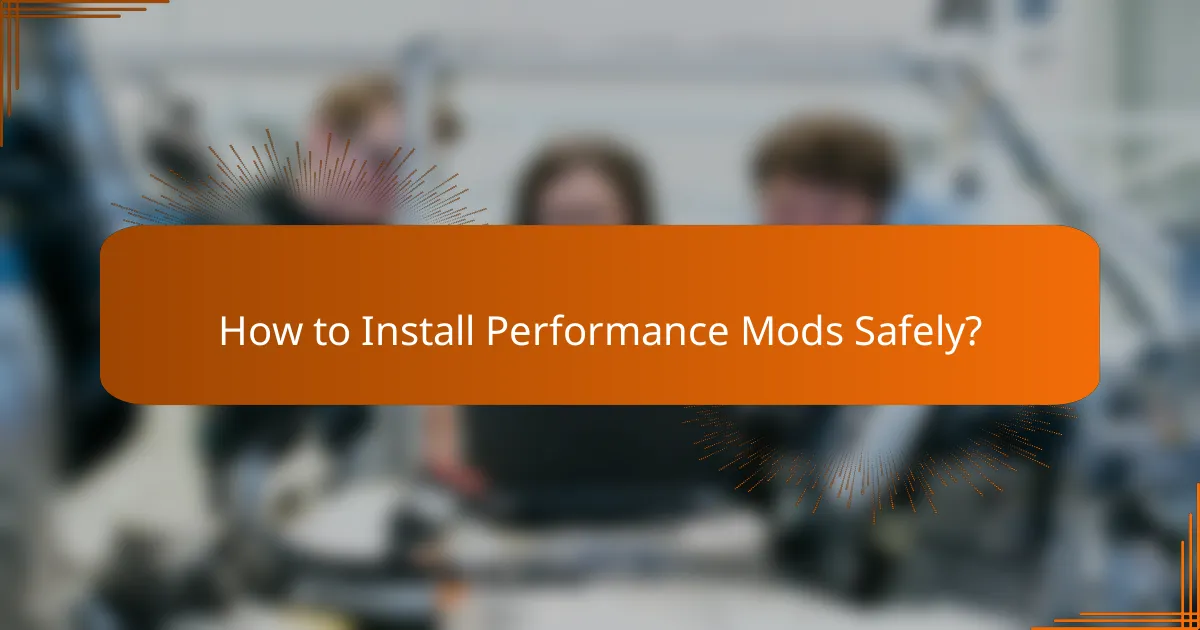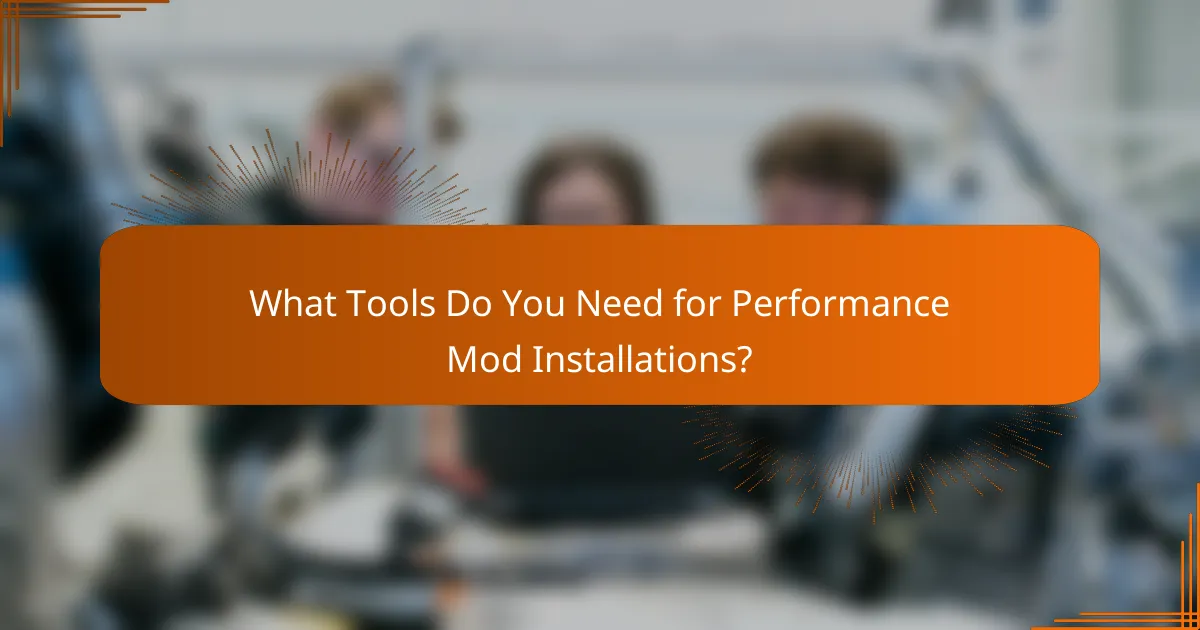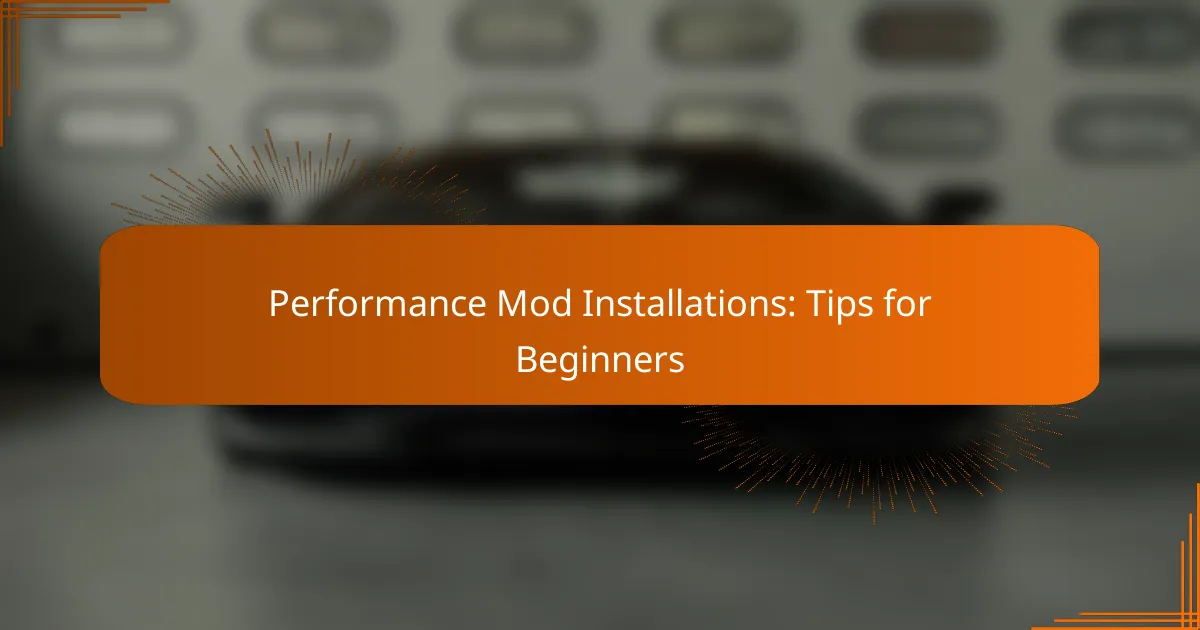Installing performance modifications can greatly enhance your vehicle’s efficiency and handling, making it an exciting project for beginners. Focus on upgrades like cold air intakes and performance exhaust systems that don’t require extensive mechanical knowledge. Proper preparation, the right tools, and understanding safety precautions are essential for a successful installation experience.

What Are the Best Performance Modifications for Beginners?
For beginners, the best performance modifications focus on enhancing engine efficiency, sound, and handling without requiring extensive mechanical knowledge. Popular options include cold air intakes, performance exhaust systems, ECU tuning, suspension upgrades, and brake enhancements.
Cold Air Intake Systems
Cold air intake systems improve engine performance by allowing cooler, denser air to enter the engine, which can increase horsepower and torque. Installation is typically straightforward, often requiring basic tools and minimal mechanical experience.
When selecting a cold air intake, consider compatibility with your vehicle model and the potential for increased engine noise. Brands like K&N and AEM offer popular options that are generally well-reviewed.
Performance Exhaust Systems
Performance exhaust systems enhance engine output by reducing back pressure and improving exhaust flow. This modification not only boosts horsepower but also provides a more aggressive sound that many enthusiasts appreciate.
Look for systems made from stainless steel for durability and resistance to rust. Brands such as Borla and MagnaFlow are known for their quality and performance gains. Installation can often be done at home with basic tools, but professional help may be advisable for complex setups.
ECU Tuning Options
ECU tuning modifies the vehicle’s engine control unit to optimize performance parameters like fuel mixture and ignition timing. This can lead to significant improvements in power and efficiency, making it a popular choice for beginners.
Consider using a plug-and-play tuner or a handheld device for ease of use. Many options are available for various vehicle models, and it’s crucial to ensure that any tuning complies with local emissions regulations.
Suspension Upgrades
Suspension upgrades enhance handling and ride quality by improving the vehicle’s stability and responsiveness. Common modifications include upgrading shocks, struts, and springs to better manage weight transfer during acceleration and cornering.
When choosing suspension components, consider your driving style and whether you prefer a firmer or softer ride. Brands like Eibach and Bilstein offer a range of options suitable for beginners, and installation can often be done with basic tools.
Brake System Enhancements
Brake system enhancements improve stopping power and overall safety. Upgrading to performance brake pads and rotors can significantly reduce stopping distances and enhance pedal feel.
When selecting brake components, look for options that are compatible with your vehicle and consider factors like heat dissipation and dust production. Brands such as Hawk and Brembo provide reliable products that can be installed with basic mechanical skills.

How to Install Performance Mods Safely?
To install performance mods safely, prioritize preparation and the right equipment. Understanding the necessary safety precautions and setting up your workspace properly can significantly reduce risks during the installation process.
Essential Safety Gear
Wearing the right safety gear is crucial when installing performance mods. At a minimum, you should use safety glasses to protect your eyes from debris and gloves to safeguard your hands from sharp edges and chemicals.
Consider wearing a dust mask or respirator if you are working with materials that produce dust or fumes. Steel-toed boots can also provide foot protection, especially in a garage environment where heavy parts may fall.
Proper Workspace Setup
A well-organized workspace is essential for a safe installation. Ensure your area is clean, well-lit, and free of clutter to prevent accidents. Use a sturdy workbench to hold tools and parts securely.
Keep all necessary tools within reach to minimize movement around the workspace. If you’re working on a vehicle, ensure it is parked on a flat surface and use wheel chocks to prevent rolling.
Common Safety Precautions
Before starting, always disconnect the vehicle’s battery to prevent electrical shocks or shorts. Familiarize yourself with the tools you will be using, and never rush through the installation process.
It’s also wise to have a fire extinguisher nearby, especially if you are working with flammable materials. Regularly check for leaks or spills and clean them up immediately to avoid slips or fire hazards.

What Tools Do You Need for Performance Mod Installations?
To successfully install performance modifications, you’ll need a mix of basic hand tools and specialized equipment. Having the right tools ensures a smoother installation process and helps avoid damage to your vehicle.
Basic Hand Tools
Basic hand tools are essential for any performance mod installation. Common tools include wrenches, screwdrivers, pliers, and sockets. A good set of metric and standard sizes will cover most needs, especially for vehicles that use a mix of fasteners.
Consider investing in a torque wrench to ensure that bolts are tightened to the manufacturer’s specifications. This prevents over-tightening, which can lead to stripped threads or damaged components.
Specialized Performance Tools
Specialized performance tools may be necessary depending on the modifications you plan to install. For example, an O2 sensor socket is crucial for exhaust modifications, while a fuel line disconnect tool is needed for fuel system upgrades.
Additionally, a diagnostic scanner can help you troubleshoot issues after installation. This tool reads error codes and provides insights into your vehicle’s performance, ensuring everything is functioning correctly post-modification.
Recommended Tool Brands
When selecting tools for performance mod installations, certain brands are known for their reliability and quality. Brands like Craftsman, Snap-on, and Matco are popular among automotive enthusiasts for their durability and precision.
For specialized tools, consider brands like OTC and Lisle, which offer a range of automotive-specific tools. Investing in reputable brands can save you money in the long run, as quality tools last longer and perform better.

What Are the Costs Involved in Performance Mod Installations?
The costs of performance mod installations can vary widely based on the type of modifications, parts, and whether you choose professional help or DIY. Understanding these costs helps you budget effectively and make informed decisions about enhancing your vehicle’s performance.
Average Cost of Parts
The average cost of parts for performance modifications typically ranges from a few hundred to several thousand dollars, depending on the complexity and type of upgrade. For instance, basic upgrades like air filters or exhaust systems may cost between $100 and $500, while more advanced modifications like turbochargers can exceed $2,000.
When selecting parts, consider quality and brand reputation, as these factors can significantly affect both performance and longevity. Researching and comparing prices from different suppliers can also help you find the best deals.
Labor Costs for Professional Installations
If you opt for professional installation, labor costs can add significantly to your total expenses. Rates typically range from $50 to $150 per hour, depending on the shop’s location and expertise. Simple installations may take a couple of hours, while more complex modifications could require a full day or more.
Always request a detailed estimate before proceeding with any work, and ensure the shop has experience with the specific modifications you want. This can prevent unexpected costs and ensure quality workmanship.
Budgeting for DIY Installations
For those considering DIY installations, budgeting should include both parts and any necessary tools or equipment. While you can save on labor costs, be prepared to invest in tools that may range from $50 to $300, depending on what you already own.
Before starting, create a checklist of required parts and tools, and set aside extra funds for any unforeseen expenses. Additionally, ensure you have access to reliable guides or videos to help you through the installation process, as this can save time and reduce mistakes.

What Are Common Mistakes to Avoid?
Beginners often make several common mistakes during performance mod installations that can lead to poor results or even damage. Being aware of these pitfalls can save time, money, and frustration.
Overlooking Manufacturer Instructions
One of the most frequent mistakes is ignoring the manufacturer instructions that come with performance parts. These guidelines provide essential information on installation procedures, torque specifications, and maintenance requirements. Following them closely ensures that the modifications perform as intended and maintain warranty coverage.
Before starting any installation, take the time to read through the instructions thoroughly. Highlight key steps and keep the manual handy during the process to avoid missing crucial details. If any part of the instructions is unclear, consider reaching out to the manufacturer for clarification.
Ignoring Compatibility Issues
Compatibility is critical when installing performance mods, as using parts that do not work well together can lead to suboptimal performance or even damage. Always verify that the new components are designed to work with your specific vehicle make and model. This includes checking engine types, transmission compatibility, and any necessary supporting modifications.
To avoid compatibility issues, research online forums or communities related to your vehicle. Many enthusiasts share their experiences and can provide insights on which parts work best together. Additionally, consider consulting with a professional mechanic if you’re unsure about the compatibility of certain components.
